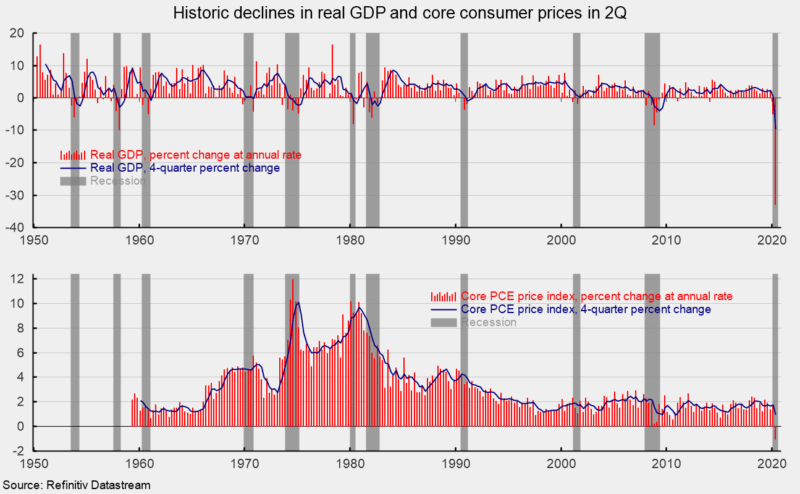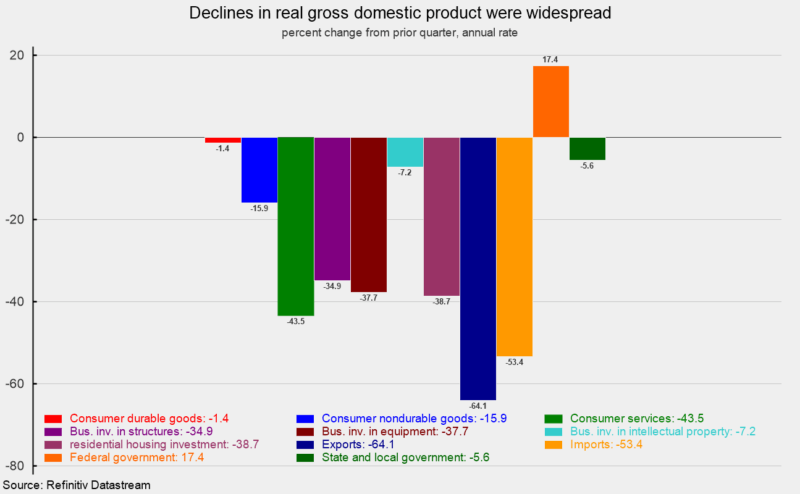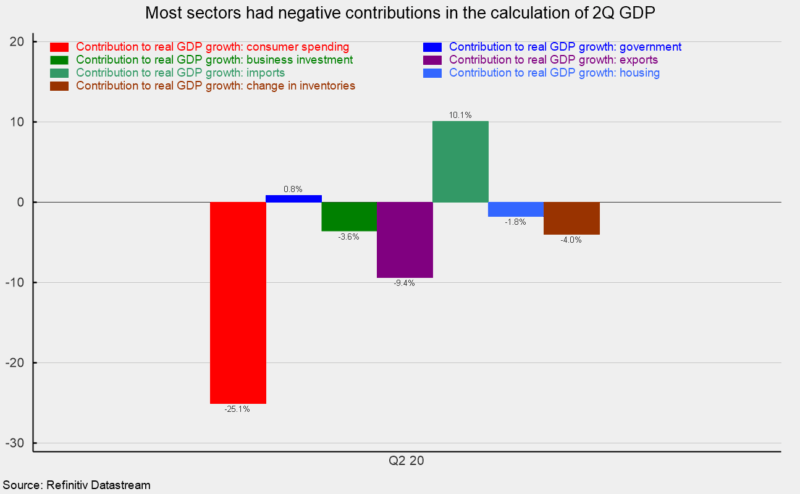U.S. Economy Posts Record Decline During Lockdowns
Real gross domestic product plunged at a historic 32.9 percent annualized rate in the second quarter, down sharply from a severe -5.0 percent pace of decline in the first quarter. Over the past four quarters, real gross domestic product is down 9.5 percent, the worst year-over-year on record (see first chart). On a nominal basis, gross domestic product tumbled 34.3 percent in the second quarter, putting the change from a year ago at -9.0 percent.
The historic plunge in the second quarter was expected as the outbreak of COVID-19 and government responses including shelter-in-place orders for individuals and the shutdown of nonessential businesses crushed the labor market and most economic activity.
Declines were widespread across the different areas of the economy. Real consumer spending declined sharply in the second quarter, falling at a 34.6 percent pace compared to a -6.9 percent rate in the first quarter. The decline was the result of drops in spending on durable-goods (down 1.4 percent) nondurable-goods (-15.9 percent), and services (-43.5 percent, see second chart). Among the few bright spots, spending on recreational goods and vehicles rose at a 40.5 percent pace while motor vehicles and part spending rose at a 5.5 percent annual rate. Notable weakness came from recreation services (-93.5 percent annualized), transportation services (-83.9 percent), food services and accommodations (-81.2 percent), and the catch-all other services (-59.1 percent).
Business fixed investment fell at a 27.0 percent annualized rate in the second quarter of 2020. That decline was led by a 37.7 percent fall in spending on equipment while spending on structures fell 34.9 percent and Intellectual-property investment fell at a 7.2 percent pace (see second chart).
Residential investment, or housing, dropped at a 38.7 percent annual rate in the second quarter compared to a 19.0 percent gain in the prior quarter. Housing has shown some resilience in the current environment as extremely low interest rates combined with the desire by some people to move away from virus epicenters created some demand.
Businesses liquidated inventory at a $315.5 billion annual rate (in real terms) in the second quarter, subtracting 3.98 percentage points from first-quarter growth after subtracting 1.34 percentage points in the prior quarter. Inventory liquidation has reduced real gross domestic product for five consecutive quarters.
Exports declined at a 64.1 percent pace, subtracting 9.38 percentage points, while imports declined at a 53.4 percent rate (see second chart). Since imports count as a negative in the calculation of gross domestic product, a drop in imports is a positive for GDP growth, adding 10.06 percentage points. Net trade, as used in the calculation of gross domestic product, added 0.68 percentage points to overall growth.
Government spending rose at a 2.7 percent annualized rate in the second quarter compared to a 1.3 percent gain in the first quarter, contributing 0.82 percentage points to growth versus a 0.22-point contribution in the first quarter of the year. Within that total, federal government spending rose at a 17.4 percent annual rate while state and local governments saw a 5.6 percent annualized decline (see second chart).
Real final sales to private domestic purchasers, a key measure of private domestic demand, fell at a 33.7 percent annualized rate in the second quarter, versus a 5.8 percent pace of decline in the first quarter.
Consumer price measures also showed declines in the second quarter. The personal-consumption price index fell at a 1.9 percent annualized rate, down from a 1.3 percent pace in the first quarter. From a year ago, the index is up 0.6 percent, well below the Federal Reserve’s 2 percent target. Excluding the volatile food and energy categories, the core PCE (personal consumption expenditures) index fell at a 1.1 percent pace, the first quarterly decline on record (see bottom of first chart). From a year ago, the core PCE index is up 1.0 percent and has been at or below 2 percent since 2012.
The U.S. economy suffered a historic contraction in the second quarter as government shutdowns intended to fight the COVID-19 outbreak sent economic activity plunging and unemployment soaring. Reopening has allowed some partial rebounds in some areas of the economy but has also coincided with a resurgence of new cases and deaths attributed to COVID-19. The potential for uncertainty, confusion, and risk aversion among consumers and businesses along with the renewed shutdown efforts in some areas puts the germinating recovery at great risk.








